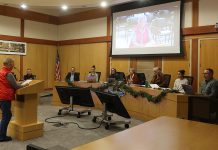Cold-weather fire triggers include chimneys, holiday decorations
Though the colder months usher in opportunities to enjoy a warm fireplace, display holiday decorations and cook meals for visiting family and friends, these activities can also serve as triggers for wintertime fires. Fire officials are recommending simple precautionary measures to help mitigate fire-related risks throughout the winter.
During the cold weather months, “people are doing a lot more cooking, people are using their fireplaces,” said Cyndi Foreman, who is a fire prevention officer with the Central Fire Authority of Sonoma County. According to the National Fire Protection Association (NFPA), home fires occur more often in winter than in any other season.
The NFPA also asserts that half of all home-heating fires occur in December, January and February. Heat-related fire triggers include the improper disposal of fireplace and barbeque ash, which can stay hot for days at a time.
“You can have a pile of ash that you’ve taken out of your fireplace and it may be a couple of days since you had a fire, however there still could be some hot coals or hot embers in there,” Foreman said. Officials encourage those who use fireplaces to dispose of ash in a metal can with a lid. The NFPA recommends that the cans be kept outside, at least 10 feet away from residences or nearby buildings.
Fireplaces and wood stoves should also be cleaned and inspected annually by a licensed contractor, according to Foreman. “It’s really common for us to get chimney fires this time of year because people are either not cleaning them or maintaining them,” she said. Fireplace fuel should consist of seasoned firewood, rather than cardboard, trash or construction scraps.
As with fireplaces and wood stoves, Foreman recommends that a qualified professional inspect and clean heating appliances and furnaces annually. Newer model space heaters may even be outfitted with safety measures such as an automatic shutoff in case they tip over.
“On the space heaters, people sometimes will throw their coats or jackets down, or blankets,” said Linda Collister, who is the fire marshal for the Healdsburg Fire Department. When in use, space heaters should have a three-foot clearance surrounding them.
In the kitchen, leaving cooking food unattended may spark fires. “If somebody’s got a house full of family, and they’ve got something on the stove, it’s really easy to get sidetracked and forget about it,” Foreman said. “People put their turkeys in the oven and go to the mall – that’s really a bad habit. If you’re going to be cooking, you should be home and you should be in the kitchen paying attention to it.”
“Cooking is one of the biggest fire hazards during the holidays,” Collister said. “Also if you’re planning on doing any deep-fried turkeys, make sure you watch them. You don’t want to put a frozen turkey in deep-fried fat, because it’s explosive.”
Foreman encourages those who experience a burn to call 911 immediately and cool the burn solely with water until help arrives.
Action can also be taken to mitigate risks associated with holiday decorations such as Christmas trees. “Right after Thanksgiving, people get natural-cut trees,” Collister said. “And so just make sure that you put a clean cut on the bottom of the tree when you purchase it.” Fire retardant sprays are also available for Christmas trees.
As Christmas trees dry out, they become more hazardous. “The problem with bringing a live tree in and not giving it adequate water is that it dries out quite quickly and creates quite a fire hazard in your home,” Foreman said. “We want to be sure that people are keeping them watered daily, that they are far away from fireplaces and candles and heaters.” Christmas trees should also be kept away from a home’s exit routes in case a fire does occur.
People should also inspect their Christmas lights and extension cords to be sure they are in good condition, and not cracked or frayed. Holiday decoration-enthusiasts should remember that outlets overloaded with plugs might prompt an electrical fire.
“It’s important that people use good discretion when they are bringing in all these extra things that get plugged in,” Foreman said. “We want them using approved, UL listed multi-plug adaptors with built-in surge protection… And those should be plugged directly into the outlet itself. So we never want to see those multi-plug adaptors used off extension cords or each other.”
As at any time of the year, smoke and carbon monoxide alarms should be tested every month and have their batteries changed two times a year. Smoke alarms have about a 10-year lifespan, Foreman said, and she encourages those changing out their alarms to upgrade to models with 10-year batteries that are now on the market.
“Not only are you not having to change the batteries two times a year, we’re also not filling the landfill with batteries,” Foreman said. “And you don’t have to worry about the battery for 10 years.” Even after upgrading, smoke alarms should still be tested every month.
Foreman also emphasized the importance of home fire escape plans, which proved beneficial to a residence on Kristine Way that experienced a recent fire. “They had trained so many times with their residents on their evacuation drill,” she said. “…Everybody knew what to do and everybody knew where to go,” and made their way to safety before the fire department arrived.








